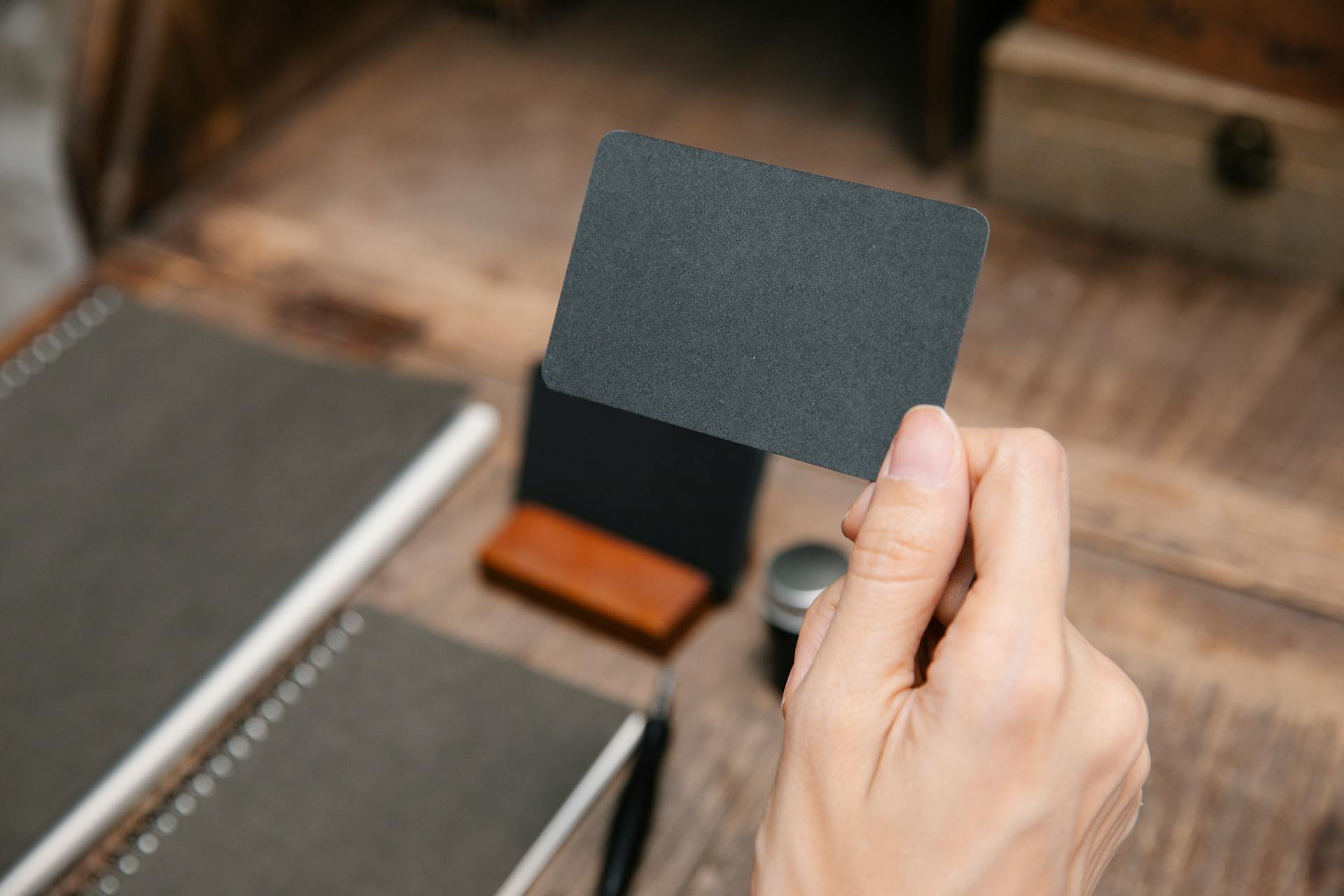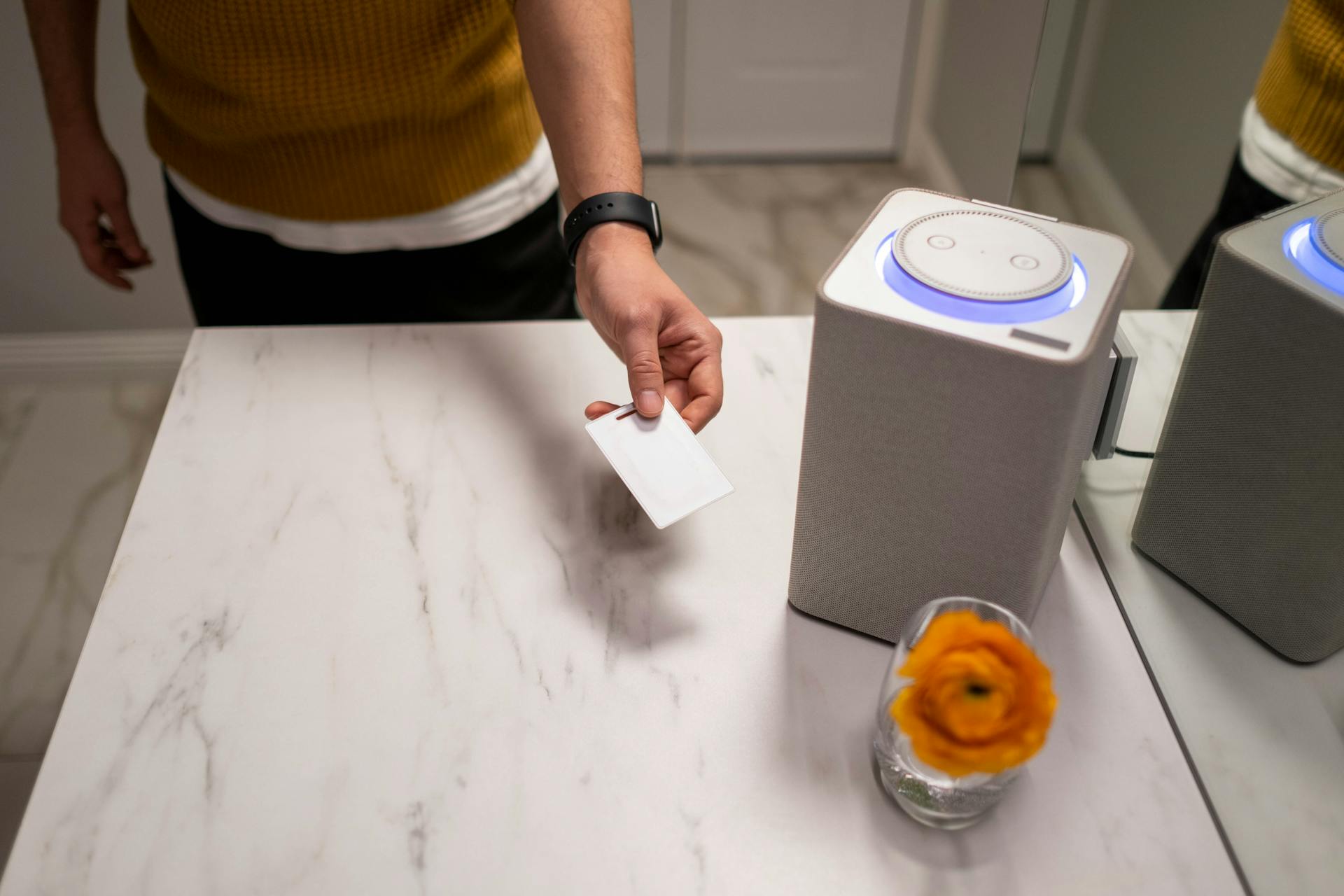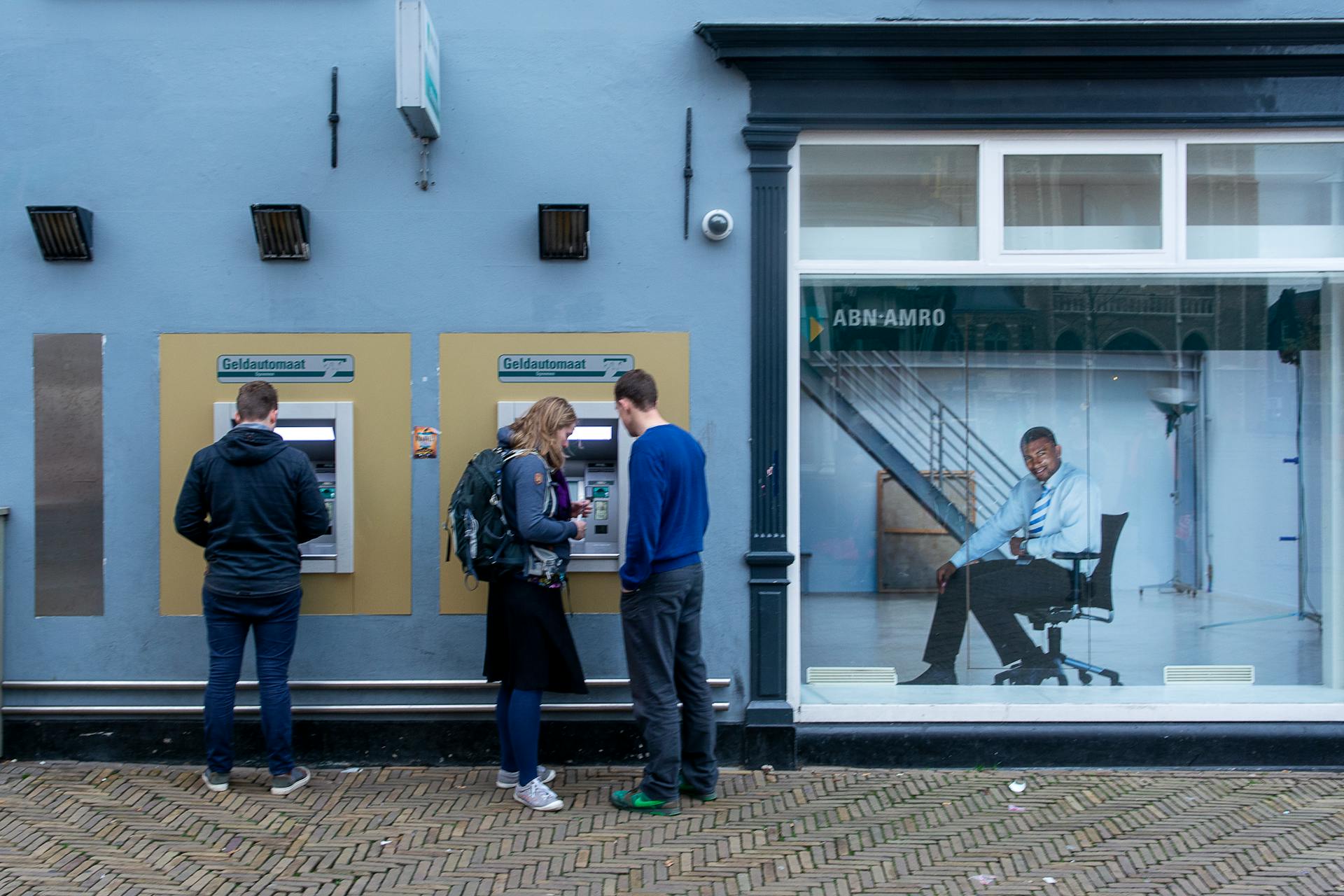
Bank signature cards are a crucial part of managing your finances, and understanding how they work is essential for making informed decisions about your money.
A bank signature card, also known as a signature card, is a document that allows you to access and manage your bank account. It typically includes your account number, account type, and your signature, which serves as a form of identification.
To open a bank account, you'll usually need to sign a signature card, which is then used to verify your identity and authorize transactions. This card is often used in conjunction with a debit card or checkbook.
Your signature on the card is what gives you permission to withdraw cash, write checks, or make online transactions from your account.
Broaden your view: Credit Card Funding Bank Account
What is a Bank Signature Card
A bank signature card is a document used by financial institutions to authenticate a customer's signature for personal and business bank accounts. It's typically signed when opening a new account or adding/removing account holders.
Intriguing read: What Is Account Number on Bank Card
This document is used to collect information about the person requesting the account and specify who can withdraw funds from it. Any co-owners or authorized users must also sign the card.
The bank keeps the signature card on file to verify identities when servicing the account. If you open an account online, you may be asked to print and sign the card, then mail it or submit your signature electronically.
A bank signature card is not legally required, but many banks still use them as a security measure. The primary purpose is to authenticate financial transactions and prevent fraudulent activity.
Here are the key features of a bank signature card:
- Identity Verification: Features signatures of account holders, allowing banks to match signatures during transactions.
- Security Measures: Identifies discrepancies if unauthorized individuals attempt transactions, providing fraud protection.
- Legal Documentation: Acts as a binding agreement, outlining rules for the use of a signature in banking operations.
- Transaction Authentication: Ensures that the signature on transactions matches the one on the card, validating the account holder's approval.
Getting a Signature Card
To get a signature card, you'll first need to contact the bank to open a new account. This can usually be done online or by visiting a local branch.
You'll need to provide a valid government-issued photo ID, such as a driver's license or passport, along with your birthdate, Social Security number, and contact information.
How to Get a Signature
Getting a signature card is an essential part of opening a new bank account. This card establishes a reference signature for future transactions.
You can obtain a bank signature card by following these simple steps.
To modify and electronically sign a bank signature card sample, you'll need to find the signature card for your bank account and click on Get Form to begin.
The process is straightforward: use the tools provided to fill out your form, and emphasize relevant sections of your documents or obscure sensitive information as needed.
You can create your electronic signature using the Sign tool, which takes just a few seconds and carries the same legal validity as a conventional wet ink signature.
To review all details and save your changes, click on the Done button. Then, select how you wish to send your form, via email, text message (SMS), or invitation link, or download it to your computer.

Here are the steps to electronically sign a bank signature card sample:
- Find signature card for bank account and click on Get Form to begin.
- Use the tools we provide to fill out your form.
- Emphasize relevant sections of your documents or obscure sensitive information with tools specifically designed by airSlate SignNow for that purpose.
- Create your electronic signature using the Sign tool, which takes just a few seconds and carries the same legal validity as a conventional wet ink signature.
- Review all details and click on the Done button to save your changes.
- Select how you wish to send your form, via email, text message (SMS), or invitation link, or download it to your computer.
How to Apply
To apply for a signature card, you may need to contact the bank in person or online. You can usually open a new bank account online, but some banks require a visit to a local branch.
The bank will ask for a valid government-issued photo ID, such as a driver's license or a passport. This is a standard requirement for opening a new bank account.
You'll also need to provide your birthdate, Social Security number, and contact information to the bank. This information is used to verify your identity and set up your account.
If you're applying for a signature card with someone else, you'll need to provide identification details for them as well. This includes their name, date of birth, and contact information.
Some banks require an initial deposit to open a new account, while others don't. Check with the bank ahead of time to see if this is a requirement.
Once you've completed the application process, you'll be asked to sign the signature card. This can be done in person or, if you're applying online, you'll need to print out the form, sign it, and mail it to the bank.
Discover more: All Bank Online Banking
Importance and Verification
Signature cards play a vital role in banking by ensuring identity verification and preventing fraud. They act as a safeguard for both the bank and the account holder.
Banks use signature cards to confirm account holders’ identities. This process reduces errors and maintains the account’s integrity, supporting secure banking operations. By comparing in-person signatures on transaction documents with those on file, banks can efficiently authenticate an individual’s identity.
Consider reading: Banks and Banking Services
Importance
Signature cards are a vital tool in banking, acting as a safeguard for both the bank and the account holder.
Banks use signature cards to prevent fraud by verifying account holders' identities.
They store the signature on file as a reference for all future transactions, making it easier to compare and authenticate identities.
This process reduces errors and maintains the account's integrity, supporting secure banking operations.
By confirming identities, banks can ensure that transactions are legitimate and not carried out by someone attempting to impersonate the account holder.
Recommended read: Private Banking Banks
LCR Procedures

To verify the signature card for a unit's bank account, you can follow these steps.
First, access the LCR Finance menu and select Reports, then Signature Card. The Signature Cards page will be displayed.
From this page, click Update Card and the form will be populated with the applicable unit leaders, including their names, positions, and phone numbers.
Print the signature card and obtain signatures from the unit leaders.
After the card is printed and signatures are obtained, create an electronic copy by taking a picture or scanning the card.
Save the electronic copy on the computer being used to print the signature card.
To upload the electronic copy, select the Print Card button and choose the electronic file copied to the computer, or drag the file to the designated box shown.
Once the new signature card is uploaded, the unit leader will review and approve it by selecting the Approve button.
Broaden your view: Does the Bank Check Signatures on Checks
Security and Protection
airSlate SignNow provides SOC 2 Type II and PCI DSS certification, ensuring the protection of online user data and payment details. This is just one of the many security measures in place to safeguard your signature card.
Two-factor authentication adds an extra layer of security, validating other parties' identities through additional means such as a text message or phone call. This helps to prevent unauthorized access to your account.
A baseline signature on your signature card helps banks detect discrepancies in unauthorized attempts to access accounts. If inconsistencies arise, banks may flag the transaction for further inquiry, preventing potential fraud.
Here are the key security measures you can expect from airSlate SignNow:
- SOC 2 Type II and PCI DSS certification
- FERPA, CCPA, HIPAA, and GDPR compliance
- Two-factor authentication
- Audit Trail
- 256-bit encryption
Fraud Prevention
Signature cards play a significant role in preventing fraudulent activities by providing a baseline signature that banks can use to detect discrepancies in unauthorized attempts to access accounts.
Banks compare the signature on the document with the one in their records to identify inconsistencies.
This mechanism is crucial in protecting both financial institutions and customers from financial losses caused by unauthorized transactions.
Fraudulent activities can be prevented by using signature cards, which help banks to detect and flag suspicious transactions for further inquiry.
You might like: What Banks Offer Secured Credit Card
How to Protect Your Sample Online

Protecting your online sample is crucial, and fortunately, there are several measures you can take to ensure its security.
SOC 2 Type II and PCI DSS certification protect online user data and payment details. These legal frameworks are in place to safeguard sensitive information.
Two-factor authentication adds an extra layer of security by validating other parties' identities through additional means, such as a Text message or phone call. This provides an additional safeguard against unauthorized access.
A key aspect of online security is the use of 256-bit encryption, which transmits data securely to the servers. This ensures that your information remains confidential.
FERPA, CCPA, HIPAA, and GDPR are key privacy regulations in the USA and Europe. Compliance with these regulations is essential for protecting sensitive information.
An audit trail serves to catch and record identity authentication, time and date stamp, and IP. This helps to track any changes made to your online sample.
Here are some key security measures you can use to protect your online sample:
- SOC 2 Type II and PCI DSS certification
- FERPA, CCPA, HIPAA, and GDPR
- Two-factor authentication
- Audit Trail
- 256-bit encryption
Completing and Managing
Completing and managing your bank signature card is a straightforward process. Proper management enhances account safety and transaction authenticity.
To modify and electronically sign your bank signature card, follow these simple steps. Find the signature card for your bank account and click on Get Form to begin.
The process involves using tools to fill out your form, emphasizing relevant sections or obscuring sensitive information, and creating an electronic signature. This takes just a few seconds and carries the same legal validity as a conventional wet ink signature.
You can review all details and click on the Done button to save your changes. Then, select how you wish to send your form, via email, text message (SMS), or invitation link, or download it to your computer.
Quick Guide to Completing Samples
Completing samples can be a breeze with the right tools. Forget about scanning and printing out forms, and use our detailed instructions to fill out and eSign your documents online.

You can modify and electronically sign bank signature card samples without hassle. To do this, find the signature card for your bank account and click on Get Form to begin.
The tools provided will help you fill out your form quickly and efficiently. You can also use the Sign tool to create your electronic signature, which takes just a few seconds and carries the same legal validity as a conventional wet ink signature.
To review all details, click on the Done button to save your changes. Then, select how you wish to send your form, via email, text message (SMS), or invitation link, or download it to your computer.
Here's a quick summary of the steps:
- Find the signature card for your bank account and click on Get Form.
- Fill out your form using the provided tools.
- Emphasize relevant sections or obscure sensitive information as needed.
- Create your electronic signature using the Sign tool.
- Review all details and click on the Done button to save your changes.
- Send or download your completed form.
Tips for Account Management
Managing your accounts requires some effort to keep them secure and authentic. Maintaining a bank signature card involves keeping information current.
Keeping your bank signature card up-to-date is crucial for account safety. This ensures that transactions are authentic and secure.
Having outdated information on your signature card can lead to account security issues. Proper management of your signature card is essential to prevent this.
Maintaining a bank signature card involves ensuring security. This involves keeping information current to prevent account security issues.
Electronic Signatures
Electronic signatures have revolutionized the way we sign and manage documents, including bank signature cards. With just a few clicks, you can create a professional online form and a legally-binding electronic signature.
You can find signature cards for bank accounts and click on Get Form to begin the process. This is where the magic happens, and you can start filling out your form using the tools provided.
Electronic signatures carry the same legal validity as a conventional wet ink signature, so you don't have to worry about their authenticity. In fact, creating your electronic signature using the Sign tool takes just a few seconds.
To send your form, you can choose from email, text message (SMS), or invitation link, or download it to your computer. This flexibility makes it easy to share your documents with others.
Here are the steps to modify and electronically sign a bank signature card sample:
- Find signature card for bank account and click on Get Form to begin.
- Use the tools we provide to fill out your form.
- Emphasize relevant sections of your documents or obscure sensitive information with tools specifically designed by airSlate SignNow.
- Create your electronic signature using the Sign tool.
- Review all details and click on the Done button to save your changes.
- Select how you wish to send your form.
By using electronic signatures, you can say goodbye to lost or misplaced files, tedious form navigation, or mistakes that require you to print new document copies. This is especially helpful when working with important documents like bank signature cards.
Troubleshooting and Help
If you're having trouble with your bank signature card, start by checking the expiration date, which is usually located on the front of the card.
Make sure your card is activated by contacting your bank's customer service number, which can be found on the back of the card or on your bank's website.
If your card is lost or stolen, report it to your bank immediately, and they will cancel the card and issue a new one.
Your bank may also have a 24-hour customer service hotline in case you need assistance outside of regular business hours.
Don't forget to sign your new card as soon as you receive it, making sure to sign it in the designated area to avoid any issues with transactions.
Frequently Asked Questions
How long do banks keep signature cards?
Banks store signature cards for 5 years after an account is closed. This is part of their record-keeping requirements.
Sources
- https://bluenotary.us/bank-signature-card/
- https://www.lawinsider.com/dictionary/bank-signature-card
- https://www.churchofjesuschrist.org/tools/help/the-signature-card
- https://www.signnow.com/fill-and-sign-pdf-form/293661-signature-card-sample
- https://www.sofi.com/learn/content/what-is-a-bank-signature-card/
Featured Images: pexels.com


